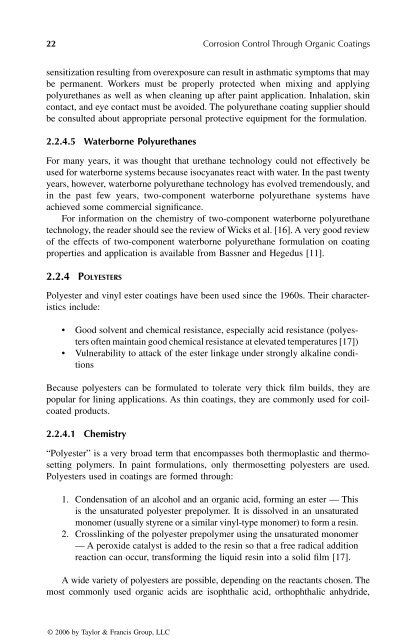© 2006 by Taylor & Francis Group, LLC
© 2006 by Taylor & Francis Group, LLC
© 2006 by Taylor & Francis Group, LLC
Create successful ePaper yourself
Turn your PDF publications into a flip-book with our unique Google optimized e-Paper software.
22 Corrosion Control Through Organic Coatings<br />
sensitization resulting from overexposure can result in asthmatic symptoms that may<br />
be permanent. Workers must be properly protected when mixing and applying<br />
polyurethanes as well as when cleaning up after paint application. Inhalation, skin<br />
contact, and eye contact must be avoided. The polyurethane coating supplier should<br />
be consulted about appropriate personal protective equipment for the formulation.<br />
2.2.4.5 Waterborne Polyurethanes<br />
For many years, it was thought that urethane technology could not effectively be<br />
used for waterborne systems because isocyanates react with water. In the past twenty<br />
years, however, waterborne polyurethane technology has evolved tremendously, and<br />
in the past few years, two-component waterborne polyurethane systems have<br />
achieved some commercial significance.<br />
For information on the chemistry of two-component waterborne polyurethane<br />
technology, the reader should see the review of Wicks et al. [16]. A very good review<br />
of the effects of two-component waterborne polyurethane formulation on coating<br />
properties and application is available from Bassner and Hegedus [11].<br />
2.2.4 POLYESTERS<br />
Polyester and vinyl ester coatings have been used since the 1960s. Their characteristics<br />
include:<br />
• Good solvent and chemical resistance, especially acid resistance (polyesters<br />
often maintain good chemical resistance at elevated temperatures [17])<br />
• Vulnerability to attack of the ester linkage under strongly alkaline conditions<br />
Because polyesters can be formulated to tolerate very thick film builds, they are<br />
popular for lining applications. As thin coatings, they are commonly used for coilcoated<br />
products.<br />
2.2.4.1 Chemistry<br />
“Polyester” is a very broad term that encompasses both thermoplastic and thermosetting<br />
polymers. In paint formulations, only thermosetting polyesters are used.<br />
Polyesters used in coatings are formed through:<br />
1. Condensation of an alcohol and an organic acid, forming an ester — This<br />
is the unsaturated polyester prepolymer. It is dissolved in an unsaturated<br />
monomer (usually styrene or a similar vinyl-type monomer) to form a resin.<br />
2. Crosslinking of the polyester prepolymer using the unsaturated monomer<br />
— A peroxide catalyst is added to the resin so that a free radical addition<br />
reaction can occur, transforming the liquid resin into a solid film [17].<br />
A wide variety of polyesters are possible, depending on the reactants chosen. The<br />
most commonly used organic acids are isophthalic acid, orthophthalic anhydride,<br />
<strong>©</strong> <strong>2006</strong> <strong>by</strong> <strong>Taylor</strong> & <strong>Francis</strong> <strong>Group</strong>, <strong>LLC</strong>
















